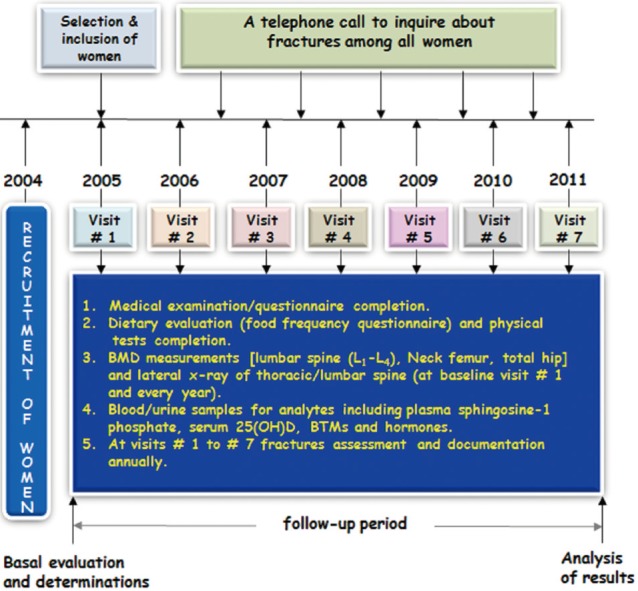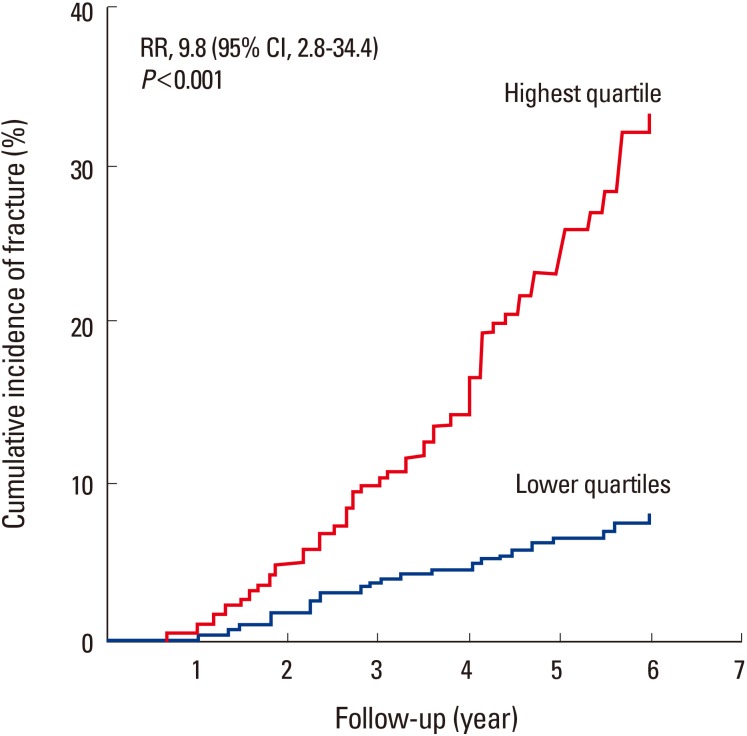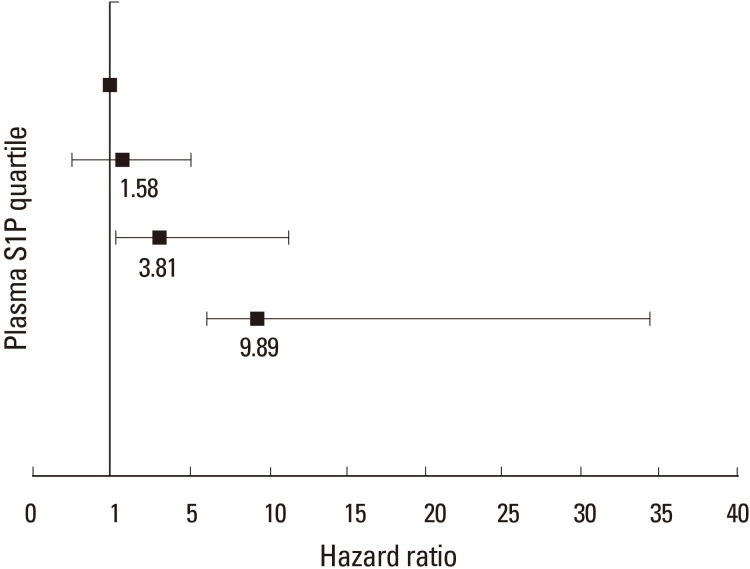J Bone Metab.
2018 May;25(2):87-98. 10.11005/jbm.2018.25.2.87.
High Plasma Sphingosine 1-phosphate Levels Predict Osteoporotic Fractures in Postmenopausal Women: The Center of Excellence for Osteoporosis Research Study
- Affiliations
-
- 1Center of Excellence for Osteoporosis Research, Faculty of Medicine, King Abdulaziz University Hospital, King Abdulaziz University, Jeddah, Saudi Arabia.
- 2Department of Clinical Biochemistry, Faculty of Medicine, King Abdulaziz University Hospital, King Abdulaziz University, Jeddah, Saudi Arabia. ayman.elsamanoudy@gmail.com
- 3Department of Obstetrics and Gynecology, Faculty of Medicine, King Abdulaziz University Hospital, King Abdulaziz University, Jeddah, Saudi Arabia.
- 4Department of Hematology, Faculty of Medicine, King Abdulaziz University Hospital, King Abdulaziz University, Jeddah, Saudi Arabia.
- 5The Pharmaceutical Research Institute, Albany College of Pharmacy and Health Sciences, Rensselaer, NY, USA.
- KMID: 2413370
- DOI: http://doi.org/10.11005/jbm.2018.25.2.87
Abstract
- BACKGROUND
Higher sphingosine 1-phosphate (S1P) plasma levels are associated with decreased bone mineral density (BMD), and increased risk of prevalent vertebral fracture. So, we hypothesized that postmenopausal women with increased baseline plasma S1P levels have a greater risk for future incident fracture (osteoporosis-related fractures [ORFs]).
METHODS
This study was conducted in a prospective longitudinal cohort of 707 women recruited in 2004 and followed up annually for a mean period of 5.2±1.3 years. They were postmenopausal (aged ≥50 years). The primary outcome measure was the time to the first confirmed ORF event using radiographs and/or a surgical report.
RESULTS
The plasma S1P levels (µmol/L) were significantly higher in the women with incident fracture (7.23±0.79) than in those without ORFs (5.02±0.51; P < 0.001). High S1P levels were strongly associated with increased fracture risk. After adjustment for age and other confounders, the hazard ratio (HR) was 6.12 (95% confidence interval [CI], 4.92−7.66) for each 1-standard deviation increase in plasma S1P levels. The women in the highest quartile of S1P levels had a significant increase in fracture risk (HR, 9.89; 95% CI, 2.83−34.44). Results were similar when we compared plasma S1P levels at the 1-year visit.
CONCLUSIONS
The associations between plasma S1P levels and fracture risk were independent of BMD and other confounders. These findings demonstrate that high plasma S1P level at baseline and at years 1 to 5 is a strong and independent risk factor for future [ORFs] among postmenopausal women and could be a useful biomarker for fracture risk assessment in this population.
MeSH Terms
Figure
Cited by 1 articles
-
Potential Biomarkers to Improve the Prediction of Osteoporotic Fractures
Beom-Jun Kim, Seung Hun Lee, Jung-Min Koh
Endocrinol Metab. 2020;35(1):55-63. doi: 10.3803/EnM.2020.35.1.55.
Reference
-
1. Garnero P, Delmas PD. Contribution of bone mineral density and bone turnover markers to the estimation of risk of osteoporotic fracture in postmenopausal women. J Musculoskelet Neuronal Interact. 2004; 4:50–63. PMID: 15615078.2. Sattui SE, Saag KG. Fracture mortality: associations with epidemiology and osteoporosis treatment. Nat Rev Endocrinol. 2014; 10:592–602. PMID: 25091729.
Article3. Chopin F, Biver E, Funck-Brentano T, et al. Prognostic interest of bone turnover markers in the management of postmenopausal osteoporosis. Joint Bone Spine. 2012; 79:26–31. PMID: 21723772.
Article4. Garnero P, Cloos P, Sornay-Rendu E, et al. Type I collagen racemization and isomerization and the risk of fracture in postmenopausal women: the OFELY prospective study. J Bone Miner Res. 2002; 17:826–833. PMID: 12009013.
Article5. Ardawi MS, Rouzi AA, Al-Sibiani SA, et al. High serum sclerostin predicts the occurrence of osteoporotic fractures in postmenopausal women: the Center of Excellence for Osteoporosis Research Study. J Bone Miner Res. 2012; 27:2592–2602. PMID: 22836717.
Article6. Proia RL, Hla T. Emerging biology of sphingosine-1-phosphate: its role in pathogenesis and therapy. J Clin Invest. 2015; 125:1379–1387. PMID: 25831442.
Article7. Rosen H, Stevens RC, Hanson M, et al. Sphingosine-1-phosphate and its receptors: structure, signaling, and influence. Annu Rev Biochem. 2013; 82:637–662. PMID: 23527695.
Article8. Ishii M, Kikuta J. Sphingosine-1-phosphate signaling controlling osteoclasts and bone homeostasis. Biochim Biophys Acta. 2013; 1831:223–227. PMID: 22691949.
Article9. Ryu J, Kim HJ, Chang EJ, et al. Sphingosine 1-phosphate as a regulator of osteoclast differentiation and osteoclast-osteoblast coupling. EMBO J. 2006; 25:5840–5851. PMID: 17124500.
Article10. Ishii M, Kikuta J, Shimazu Y, et al. Chemorepulsion by blood S1P regulates osteoclast precursor mobilization and bone remodeling in vivo. J Exp Med. 2010; 207:2793–2798. PMID: 21135136.
Article11. Ishii M, Egen JG, Klauschen F, et al. Sphingosine-1-phosphate mobilizes osteoclast precursors and regulates bone homeostasis. Nature. 2009; 458:524–528. PMID: 19204730.
Article12. Kim BJ, Koh JM, Lee SY, et al. Plasma sphingosine 1-phosphate levels and the risk of vertebral fracture in postmenopausal women. J Clin Endocrinol Metab. 2012; 97:3807–3814. PMID: 22879631.
Article13. Heilmann A, Schinke T, Bindl R, et al. Systemic treatment with the sphingosine-1-phosphate analog FTY720 does not improve fracture healing in mice. J Orthop Res. 2013; 31:1845–1850. PMID: 23818033.
Article14. Grey A, Chen Q, Callon K, et al. The phospholipids sphingosine-1-phosphate and lysophosphatidic acid prevent apoptosis in osteoblastic cells via a signaling pathway involving G(i) proteins and phosphatidylinositol-3 kinase. Endocrinology. 2002; 143:4755–4763. PMID: 12446603.
Article15. Lotinun S, Kiviranta R, Matsubara T, et al. Osteoclast-specific cathepsin K deletion stimulates S1P-dependent bone formation. J Clin Invest. 2013; 123:666–681. PMID: 23321671.
Article16. Sefcik LS, Aronin CE, Awojoodu AO, et al. Selective activation of sphingosine 1-phosphate receptors 1 and 3 promotes local microvascular network growth. Tissue Eng Part A. 2011; 17:617–629. PMID: 20874260.
Article17. Rouzi AA, Al-Sibiani SA, Al-Senani NS, et al. Independent predictors of all osteoporosis-related fractures among healthy Saudi postmenopausal women: the CEOR Study. Bone. 2012; 50:713–722. PMID: 22178778.
Article18. World Health Organization. International statistical classification of diseases and related health problems 10th revision (ICD-10). Geneva, CH: World Health Organization;1992.19. Genant HK, Wu CY, van Kuijk C, et al. Vertebral fracture assessment using a semiquantitative technique. J Bone Miner Res. 1993; 8:1137–1148. PMID: 8237484.
Article20. Lai WQ, Irwan AW, Goh HH, et al. Anti-inflammatory effects of sphingosine kinase modulation in inflammatory arthritis. J Immunol. 2008; 181:8010–8017. PMID: 19017993.
Article21. Ardawi MS, Maimani AA, Bahksh TA, et al. Reference intervals of biochemical bone turnover markers for Saudi Arabian women: a cross-sectional study. Bone. 2010; 47:804–814. PMID: 20659600.
Article22. Ardawi MS, Al-Kadi HA, Rouzi AA, et al. Determinants of serum sclerostin in healthy pre- and postmenopausal women. J Bone Miner Res. 2011; 26:2812–2822. PMID: 21812027.
Article23. Hennekens CH, Buring JE. Measure of disease frequency and association. In : Mayrent SL, editor. Epidemiology in medicine. Boston, MA: Little, Brown and Company;1997. p. 87–95.24. Lee SH, Lee SY, Lee YS, et al. Higher circulating sphingosine 1-phosphate levels are associated with lower bone mineral density and higher bone resorption marker in humans. J Clin Endocrinol Metab. 2012; 97:E1421–E1428. PMID: 22679064.
Article25. Ivaska KK, Gerdhem P, Väänänen HK, et al. Bone turnover markers and prediction of fracture: a prospective follow-up study of 1040 elderly women for a mean of 9 years. J Bone Miner Res. 2010; 25:393–403. PMID: 19961336.
Article26. Grey A, Xu X, Hill B, et al. Osteoblastic cells express phospholipid receptors and phosphatases and proliferate in response to sphingosine-1-phosphate. Calcif Tissue Int. 2004; 74:542–550. PMID: 15354862.
Article27. Roelofsen T, Akkers R, Beumer W, et al. Sphingosine-1-phosphate acts as a developmental stage specific inhibitor of platelet-derived growth factor-induced chemotaxis of osteoblasts. J Cell Biochem. 2008; 105:1128–1138. PMID: 18819098.
Article28. Peest U, Sensken SC, Andréani P, et al. S1P-lyase independent clearance of extracellular sphingosine 1-phosphate after dephosphorylation and cellular uptake. J Cell Biochem. 2008; 104:756–772. PMID: 18172856.
Article29. Maeda Y, Seki N, Sato N, et al. Sphingosine 1-phosphate receptor type 1 regulates egress of mature T cells from mouse bone marrow. Int Immunol. 2010; 22:515–525. PMID: 20497959.
Article30. Armas LA, Recker RR. Pathophysiology of osteoporosis: new mechanistic insights. Endocrinol Metab Clin North Am. 2012; 41:475–486. PMID: 22877425.31. Rivera J, Proia RL, Olivera A. The alliance of sphingosine-1-phosphate and its receptors in immunity. Nat Rev Immunol. 2008; 8:753–763. PMID: 18787560.
Article
- Full Text Links
- Actions
-
Cited
- CITED
-
- Close
- Share
- Similar articles
-
- The Fracture Risk Assessment Tool Probability and Trabecular Bone Score Mediate the Relationship between Sphingosine 1-phosphate Levels and Fracture Risk
- Alterations of Biochemical Markers in Osteoporotic Fractures
- The Relationships between Homocysteine, Folate, MTHER and TSER Polymorphism for Osteoporotic Compression Fracture in Postmenopausal Women
- Association of Bone Marrow Sphingosine 1-phosphate Levels with Osteoporotic Hip Fractures
- Investigation of Comorbidity, Trauma History, and Osteoporotic Fractures in the Postmenopausal Population: A Nationwide, Observational, and Cross-Sectional Study of Korean Orthopedic Outpatient Clinics




